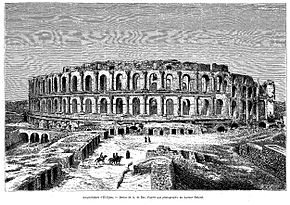Thysdrus

Thysdrus's huge amphitheater
|
|
| Location | Tunisia |
|---|---|
| Region | Mahdia Governorate |
| Coordinates | 35°18′00″N 10°43′00″E / 35.3°N 10.716667°ECoordinates: 35°18′00″N 10°43′00″E / 35.3°N 10.716667°E |
Thysdrus was a Roman-Berber colonia near present-day El Djem, Tunisia. It was served as the center of olive oil production in the province of Africa proconsularis, situated in the north-central area. The local Amphitheatre of El Jem has been a World Heritage Site since 1979.
The toponym Thysdrus has Berber roots. The city was founded by the Romans on the site of an ancient, small Berber Punic village.
Thysdrus probably received Julius Caesar's veterans as settlers in 45 BC. Thysdrus did not become a "Municipium" (settlement with partial rights of citizenship) until the reign of Septimius Severus. In 244 AD it was declared "Colonia" by emperor Gordian III.
In a less arid climate than today's, Thysdrus, which later became part of the Roman province of Byzacena, prospered especially in the 2nd century, when it became an important center of olive oil manufacturing for export. It was the seat of a Christian bishopric, which is included in the Catholic Church's list of titular sees.
Bishops attended the main councils of 393, 411 and 641, and the donatist schism had a hold in the city round 411.
Thysdrus grew to be the main center of olive oil production in Roman Africa thanks to the Romano-berber emperor Septimius Severus and his successors. So, by the early 3rd century AD, when the huge amphitheater was built, Thysdrus rivaled Hadrumetum (modern Sousse) as the second city of Roman North Africa, after Carthage. The city had even a huge "Circus", nearly as large as the Circus Maximus at Rome and capable of accommodating about 30,000 spectators.
...
Wikipedia

